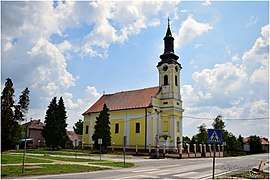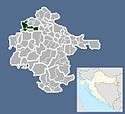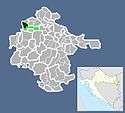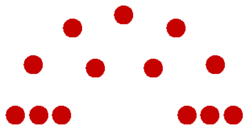Markušica
Markušica (Serbian Cyrillic: Маркушица,[6] Hungarian: Márkusfalva, German: Sankt Markus) is a village and a municipality in Vukovar-Syrmia County in eastern Croatia. Markušica is located south of the river Vuka and northwest of the town of Vinkovci. The municipality was established in 1997 by the UNTAES administration as one of new predominantly Serb municipalities in order to ensure access to local self-government to Serb community in the region. Alongside Markušica it includes villages of Gaboš, Karadžićevo, Ostrovo and Podrinje.
Markušica | |
|---|---|
| Municipality of Markušica Općina Markušica | |
 Markušica | |
 Flag  Coat of arms | |
  | |
 Markušica | |
| Coordinates: 45.373766°N 18.706208°E | |
| Country | |
| Region | Slavonia |
| County | |
| Government | |
| • Municipal mayor | Budimir Drača [2] (SDSS[2]) |
| Area | |
| • Total | 74.43 km2 (28.74 sq mi) |
| Population (2011)[4] | |
| • Total | 2,555 |
| • Density | 34/km2 (89/sq mi) |
| Time zone | UTC+1 (CET) |
| Official languages | Croatian, Serbian[5] |
| Website | www |
It is connected with the surrounding area via D518 road and L209 Vinkovci–Gaboš–Osijek railway with local stations in Gaboš and Ostrovo.
Geography
The municipality has a total area of 74.29 km2.[7] River Vuka flows through the municipality and territory of the municipality is completely flat very fertile black soil. It is connected by D518 highway with rest of country.
History
One Scordisci archaeological site in Markušica dating back to late La Tène culture was excavated in the 1970s and 1980s as a part of rescue excavations in eastern Croatia.[8] Archaeological site was a part of the settlement network of Scordisci in the area of Vinkovci.[8]
Markušica was one of the feudal villages that existed in the region before the Ottoman rule in Hungary.[9] After the end of Great Turkish War village was settled by Eastern Orthodox Vlachs from surrounding areas and the eastern Bosnia.[9] In 1736 there was 40 inhabited houses in Markušica.[9] In 1866 this number increased at 192 houses and 1003 inhabitants out of which 902 were Eastern Orthodox.[9]
Demographics
Population
There are 2 555 inhabitants, the majority of the population which are Serbs, who make up 90.10% of the population according to the 2011 population census.[10]
Languages
Due to the local minority population, the Markušica municipality prescribe the use of not only Croatian as the official language, but the Serbian language and Serbian Cyrillic alphabet as well.[11][12]
Religion
Most of the population are Serbian Orthodox that are practicing their religion in the church that was built in 1810. and re-built in 1989.
Politics
Joint Council of Municipalities
The Municipality of Markušica is one of seven Serb majority member municipalities within the Joint Council of Municipalities, inter-municipal sui generis organization of ethnic Serb community in eastern Croatia established on the basis of Erdut Agreement. As Serb community constitute majority of the population of the municipality it is represented by 2 delegated Councillors at the Assembly of the Joint Council of Municipalities, double the number of Councilors to the number from Serb minority municipalities in Eastern Croatia.[13]
Municipality government
The municipality assembly is composed of 13 representatives plus additional seats for municipality minority groups if they don't get proportional number of seats. Assembly members come from electoral lists winning more than 5% of votes. Dominant party in the municipality since the reintegration of eastern Slavonia in 1998 is Independent Democratic Serb Party. 681 or 33,32 % out of 2.044 voters participated in 2017 Croatian local elections with 93,69 % valid votes.[14] With 92,80% and 632 votes Budimir Brača from Independent Democratic Serb Party was elected as municipality major.[14] As of 2017, the member parties/lists are:
Summary of the 2017 Croatian local elections
| Party | Votes | % | Seats | ||||
|---|---|---|---|---|---|---|---|
| Independent Democratic Serb Party | 638 | 100,00 | 13 | ||||
| Invalid/blank votes | 43 | 6,31 | — | ||||
| Total | 681 | 100 | — | ||||
| Registered voters/turnout | 2.044 | 33,32 | — | ||||
 | |||||||
| Source[14] page 57-58 (in Croatian) | |||||||
Economy
Markušica is underdeveloped municipality which is statistically classified as the First Category Area of Special State Concern by the Government of Croatia.[15]
Education
Culture
Points of Interest
Markušica Municipality is famous for a monument dedicated to a soldier killed in World War II. The village has a unique monument to a female Soviet pilot from the Red Army, who fought against the Nazis and whose plane was shot down here. The village also has an Orthodox Church from 1810, which was damaged in the war in Croatia.
Associations and Institutions
The village has a volunteer fire department.[16]
Settlements
The municipality consists of the following settlements:[17]
- Gaboš
- Karadžićevo
- Markušica
- Ostrovo
- Podrinje
See also
- Vukovar-Srijem County
- Church of Pentecost, Markušica
- Joint Council of Municipalities
References
| Wikimedia Commons has media related to Markušica. |
- Government of Croatia (October 2013). "Peto izvješće Republike Hrvatske o primjeni Europske povelje o regionalnim ili manjinskim jezicima" (PDF) (in Croatian). Council of Europe. p. 36. Retrieved 30 November 2016.
- "Informacija o rezultatima izbora članova predstavničkih tijela jedinica lokalne i područne (regionalne) samouprave" (PDF). Archived from the original (PDF) on 2012-08-13. Retrieved 2013-03-10.
- "Općine na područjima posebne državne skrbi Republike Hrvatske" (PDF). Croatian Chamber of Economy. Retrieved 15 April 2020.
- "Population by Age and Sex, by Settlements, 2011 Census: Markušica". Census of Population, Households and Dwellings 2011. Zagreb: Croatian Bureau of Statistics. December 2012.
- Četvrto izvješće Republike Hrvatske o primjeni Europske povelje o regionalnim ili manjinskim jezicima, page 61., Zagreb, 2009
- "Minority names in Croatia:Registar Geografskih Imena Nacionalnih Manjina Republike Hrvatske" (PDF). Archived from the original (PDF) on 2013-10-29. Retrieved 2013-03-08.
- "Archived copy" (PDF). Archived from the original (PDF) on 2016-01-28. Retrieved 2016-01-22.CS1 maint: archived copy as title (link)
- Dizdar, Marko (2016). "Late La Tène Settlements in the Vinkovci Region (Eastern Slavonia, Croatia): Centres of Trade and Exchange" (PDF). Boii - Taurisci: Proceedings of the International Seminar, Oberleis-Klement, June 14th-15th, 2012. Austrian Academy of Sciences Press: 31–48. Retrieved 22 January 2019.
- Marković, M. (2003). Istočna Slavonija: Stanovništvo i naselja. Naklada Jesenski i Turk. Zagreb.
- "Population by Ethnicity, by Towns/Municipalities, 2011 Census: County of Vukovar-Sirmium". Census of Population, Households and Dwellings 2011. Zagreb: Croatian Bureau of Statistics. December 2012.
- Izvješće o provođenju ustavnog zakona o pravima nacionalnih manjina i o utošku sredstava osiguranih u državnom proračunu Republike Hrvatske za 2008. godinu za potrebe nacionalnih manjina, Zagreb, 2009.
- "Archived copy" (PDF). Archived from the original (PDF) on 2013-10-29. Retrieved 2013-03-08.CS1 maint: archived copy as title (link)
- "Konstituisan 6. saziv Zajedničkog veća opština l" (in Serbian). Zagreb: Privrednik. 1 August 2017.
- "Informacija o izborima članova predstavničkih tijela jedinica lokalne i područne (regionalne) samouprave i općinskih načelnika, gradonačelnika i župana te njihovih zamjenika - 2017 (Vukovarsko-srijemska županija)" (PDF) (in Croatian). Archived from the original (PDF) on 16 January 2018. Retrieved 15 January 2018.
- Lovrinčević, Željko; Davor, Mikulić; Budak, Jelena (June 2004). "AREAS OF SPECIAL STATE CONCERN IN CROATIA- REGIONAL DEVELOPMENT DIFFERENCES AND THE DEMOGRAPHIC AND EDUCATIONAL CHARACTERISTICS". Ekonomski pregled, Vol.55 No.5-6. Archived from the original on 18 August 2018. Retrieved 25 August 2018.
- "Archived copy" (PDF). Archived from the original (PDF) on 2012-04-30. Retrieved 2011-10-15.CS1 maint: archived copy as title (link)
- http://www.dzs.hr/hrv/censuses/census2001/Popis/H01_01_03/h01_01_03_zup16-6106.html


